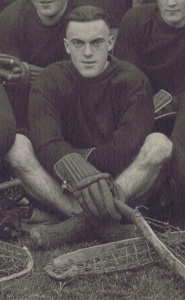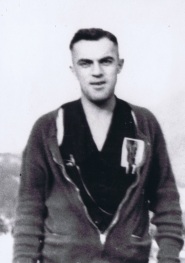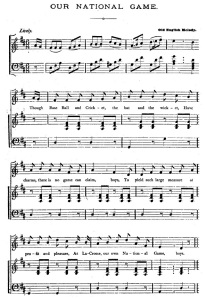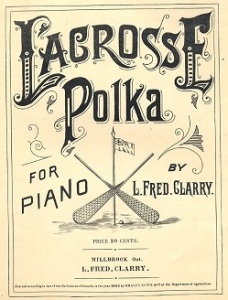
JAMES (JIMMY) ALEXANDER GUNN
(October 25, 1898 – January 13, 1987)
Vancouver Terminals (1922-1923)
New Westminster Salmonbellies (1924)
With his brief and youthful career, Jimmy Gunn was a rising star in the last days of professional lacrosse. The Vancouver Daily Province observed that Young Gunn, in his professional debut match in 1922, was “…one of the fastest fielders seen on the home [midfield] in many moons”, who possessed an accurate outlet in moving the ball near the vicinity of the opposing goalkeeper.
Gunn played 30 games over two seasons with the Vancouver Terminals before signing with his hometown team in 1924. He played in all 4 of the New Westminster Salmonbellies’ games that last season before professional lacrosse died in June 1924. He scored a career total of 17 goals and 2 assists for 19 points; he was penalised 7 times for a total of 41 minutes.
Prior to his three years as a professional player, Jimmy Gunn played with the New Westminster seniors between 1919 and 1921 and winning the Mann Cup twice during his tenure with the Royal City amateurs. One can only guess what kind of star on the midfield he would have become if the professional game hadn’t died so suddenly – when Jimmy Gunn was still 26 years young.
He was inducted into the Canadian Lacrosse Hall of Fame as a field player in 1972 although at the end of his day he clearly had more fame in the sport as a referee – officiating for 32 years and writing a referee manual for the Canadian Lacrosse Association which saw widespread distribution. With the introduction of the new Officials category by the Canadian Lacrosse Hall of Fame, Jimmy Gunn was reassigned in 2022 to this new category to better honour him and his accomplishments.
Gunn was a favourite source of story copy for local sports beat-writers and he acquired such unflattering nicknames as ‘The Stormy Petrel’, ‘Two-Gunn Jimmy’, ‘Bullets’ – or as one writer put it, “that (censored) Gunn” – due to his fierce independent temperament and personality both on and off the floor.
Changing teams during the professional era saw Gunn on the receiving end of stones thrown and cries of “traitor!” from his old Salmonbellies teammates when he walked along the streets of his Royal City hometown, although Gunn was motivated to sign with Vancouver Terminals as New Westminster seniors weren’t giving him a “square deal” when it came to his share of the money.
When the professional league died in 1924, unable to get reinstatement as an amateur player, Gunn went off to the interior of British Columbia and played in the outlaw leagues located there. This resulted in him being banned for life by the Canadian Amateur Lacrosse Association, although this ban was dropped in 1932 – coincidently around the same time the word ‘Amateur’ was dropped from the Canadian Lacrosse Association name.
These run-arounds from both teams and the governing bodies did nothing but fuel Jimmy Gunn’s rebellious nature. As he then settled into his career as a lacrosse referee, Gunn still did not stay always on the good side of governing bodies and officials.
He had the Canadian Lacrosse Association howling at him in rage once more, when in January 1939, Gunn was involved, along with Cliff Spring and Andy Paull, in the formation of the Pacific Coast Lacrosse Association, a four-team professional league based in Los Angeles, California. The league folded by the end of the month due to poor arena conditions. Due to poaching approximately two-dozen or so players from Canadian leagues and teams to populate this new professional box league, which ran during the Canadian off-season and outside of the jurisdiction of any Canadian organisational body, Jimmy Gunn nevertheless found himself once again blacklisted for the next two years.
As the unwieldly and heavy field lacrosse sticks evolved into the more rounded, crook-shape of stick used in box lacrosse during the course of the mid-1930s, Jimmy Gunn and North Shore Indians trainer Fred Brown patented a four-ply laminate lacrosse stick designed to be half the weight and twice as strong as the old field sticks, specific for indoor box usage. Their manufacturing venture in April 1937 seems to have found no takers, as no further word is heard about this stick design.

In 1945, he made North American newspaper headlines as far away as New York due to an incident that occurred at the conclusion of the 1945 Mann Cup finals. After the defending holders St. Catharines Athletics were swept by the Vancouver Burrards in three lopsided games, Jimmy Gunn, as the referee of the series, was made the scapegoat by the Easterners for their loss. After the final whistle and Vancouver now the new champions, Athletics goaltender Bill Whittaker stormed into Gunn’s dressing room. Fists and words were exchanged between the two men, and a brawl ensued.
Matters did not end there, however. Vancouver mayor Charles Jones then publicly humiliated the St. Catharines Athletics players during the team banquet hosted by the Burrards afterwards. The Athletics players in attendance all got up and walked out.
At this point, a New York reporter picked up on the story and inexplicably stepped into the fray – taking the side of St. Catharines, and branding the Vancouver team as the “Buzzards” – calling out Jimmy Gunn as “a bandit” and wishing that Bill Whittaker had beaten in Gunn’s head.
Both Whittaker and Gunn saw themselves banned by the Canadian Lacrosse Association, with Jimmy banned due his refusal to apologise for his actions, roaring at the national lacrosse fathers “For what? Defending myself?”
While Bill Whittaker was reinstated the following year, Gunn was forced to sit out three years. The provincial BCLA organisation was forced to call an emergency meeting, attended by around 100 officials, players, and supporters, to protest the CLA’s decision. When not battling the Canadian Lacrosse Association and goaltenders, Jimmy Gunn could also be found getting punched in the nose by irate female fans or hauled into court due to a game protest. Such was the colourful and never-a-dull-moment officiating career of Jimmy Gunn.
In time, the heated press and even more heated conflicts between the Inter-City box lacrosse organisers, the CLA, and “the last of the outlaws” would subside. Regardless what anyone thought of his personality, Jimmy Gunn was acknowledged and (grudgingly) respected as the most competent referee in the game and when he was not on the floor with his whistle, the league and the game suffered from his absences.
In 1969 the British Columbia Lacrosse Association named their outstanding referee achievement award after him – with awards handed out on an annual basis to the top senior and minor referees with field referees added to the class starting in 1998. Candidates for the Jimmy Gunn Merit Award are judged on their achievements toward promoting sportsmanship and the image of the game.
Like many lacrosse players of the day, Jimmy Gunn was multi-talented athlete and he excelled at many sports. He played soccer with New Westminster United, won a city championship in basketball with the New Westminster Mohawks, and was regarded as a better-than-fair baseball pitcher in the local city league. Away from team sports, he held the reputation as a good track and fielder as well as a capable boxer.
In 1926 he helped coached the Ocean Falls Amateur Athletic Association lacrosse team to the Kilmarnock Cup, the senior provincial championship trophy of British Columbia. After defeating the Richmond Farmers, Ocean Falls then progressed to the Western Canada finals, where Ocean Falls won their first game over the Winnipeg Tammany Tigers 6-5 but then lost the second game 8-6 – missing out moving on to the Mann Cup finals by 1 goal, 13-12.
Gunn served in the Canadian army from 1917 until his discharge in 1919. When he passed away in 1987, James Gunn was survived by his wife Janet and sister Catherine. He had three nieces and three nephews thanks to his sister, but he himself was not survived by any children of his own.
(PHOTO SOURCES: CLHOF X979.148.1b; CLHOF inductee collection)



You must be logged in to post a comment.